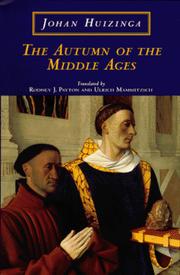Check nearby libraries
Buy this book

So begins one of the most famous works of history ever published, Johan Huizinga's The Autumn of the Middle Ages. Few who have read this book in English realize that The Waning of the Middle Ages, the only previous translation, is vastly different from the original Dutch, and incompatible with all other European-language translations. Now, for the first time ever, the original version of this classic work has been translated into English.
Herfsttij der Middeleeuwen, or The Autumn of the Middle Ages - the original title - is a brilliant portrait of life, thought, and art in fourteenth- and fifteenth- century France and the Netherlands. For Huizinga, this period marked not the birth of a dramatically new era in history, the Renaissance, but the fullest, ripest phase of medieval life and thought.
Criticized both at home and in Europe for being "old-fashioned" and "too literary" when first published in 1919, the book is now recognized not only for its quality and richness as history, but also as a precursor to the Annales "histoire des mentalites" school of Marc Bloch and Lucien Febvre, two of the few reviewers who praised the book initially.
In the 1924 translation, Fritz Hopman adapted, reduced, and altered the Dutch edition - softening Huizinga's often passionate arguments, dulling his nuances, and eliminating theoretical passages. He dropped many passages Huizinga had quoted in their original old French. Additionally, chapters are rearranged and redivided, all references are dropped, and mistranslations are introduced.
This translation corrects such errors, recreating the second Dutch edition - which represents Huizinga's thinking at its most important stage - as closely as possible. Everything that was dropped or rearranged has been restored. Prose quotations appear in French, with translations printed at the bottom of the page. Mistranslations have been corrected.
Payton and Mammitzsch also have added helpful material, including Huizinga's preface to the first and second Dutch editions (published in 1919 and 1921) and the one to the 1924 German translation, where he touches on the book's title and offers some thoughts on translations. Several notes clarify Huizinga's references to things which would be common knowledge only to Dutch readers.
Huizinga frequently refers to paintings, sculptures, and carvings, some little known; this edition is the first in any language to include a full range of illustrations.
Check nearby libraries
Buy this book

Previews available in: Dutch Italian English Croatian Spanish
Subjects
Art, Medieval, Civilization, Civilization, Medieval, Fifteenth century, Fourteenth century, History, Medieval Art, Medieval Civilization, Middle Ages, Social history, Social life and customs, Manners and customs, Conditions sociales, Civilisation médiévale, Moyen Âge, Cultuurgeschiedenis, Social conditions, Middle ages, history, France, social life and customs, Netherlands, social life and customs, Civilisation, Netherlands, history, Europe, history, 476-1492, Civilisation medievale, Mœurs et coutumes, French language books, Idade me dia, Civilización -, FRANCIA, Sec. 14.-15, Civiltà, France, civilization, Netherlands, civilizationPlaces
France, Netherlands, belgium, Pays-Bas, Franc ʹa;holandaTimes
1000-1328, 1328-1600, Medieval, 500-1500Showing 10 featured editions. View all 105 editions?
Book Details
Edition Notes
Includes bibliographical references (p. 441-449) and index.
Classifications
External Links
The Physical Object
ID Numbers
Source records
Scriblio MARC recordmarc_cca MARC record
Internet Archive item record
Internet Archive item record
OpenLibraries-Trent-MARCs record
marc_openlibraries_phillipsacademy MARC record
marc_openlibraries_sanfranciscopubliclibrary MARC record
marc_claremont_school_theology MARC record
Better World Books record
Library of Congress MARC record
marc_claremont_school_theology MARC record
Internet Archive item record
marc_nuls MARC record
marc_columbia MARC record
Work Description
Herfsttij der Middeleeuwen is het bekendste werk van de historicus Johan Huizinga uit 1919.
In het werk presenteert Huizinga het idee dat de overdreven formaliteit en romantiek van het laatmiddeleeuwse hofleven een verdedigingsmechanisme was tegen de toenemende verruwing van de maatschappij.
Huizinga gebruikte voor Herfsttij kronieken en literatuur als bronnen en bewust geen archiefstukken. Zijn boek is, meer dan een kunsthistorische studie, een proeve van cultuur- en mentaliteitsgeschiedenis.
Source: Wikipedia
From the Preface of the English translation:
The present work deals with the history of the fourteenth and fifteenth centuries regarded as a period of termination, as the close of the Middle Ages. Such a view of them presented itself to the author of this volume, whilst endeavouring to arrive at a genuine understanding of the art of the brothers Van Eyck and their contemporaries, that is to say, to grasp its meaning by seeing it in connection with the entire life of their times. Now the common feature of the various manifestations of civilization of that epoch proved to be inherent rather in that which links them to the past than in the germs which they contain of the future. The significance, not of the artists alone, but also of theologians, poets, chroniclers, princes and statesmen, could be best appreciated by considering them, not as the harbingers of a coming culture, but as perfecting and concluding the old.
This English edition is not a simple translation of the original Dutch (second edition 1921, first 1919), but the result of a work of adaptation, reduction and consolidation under the author's directions. The references, here left out, may be found in full in the original.
Community Reviews (0)
Feedback?History
- Created April 1, 2008
- 23 revisions
Wikipedia citation
×CloseCopy and paste this code into your Wikipedia page. Need help?
| July 30, 2024 | Edited by MARC Bot | import existing book |
| March 14, 2024 | Edited by bitnapper | Merge works (MRID: 123454) |
| March 8, 2023 | Edited by MARC Bot | import existing book |
| May 8, 2021 | Edited by ImportBot | import existing book |
| April 1, 2008 | Created by an anonymous user | Imported from Scriblio MARC record |






















